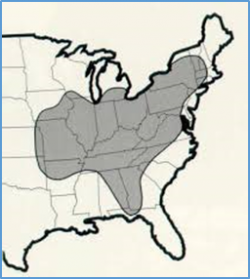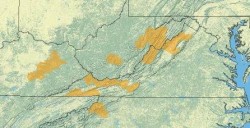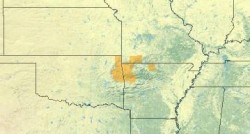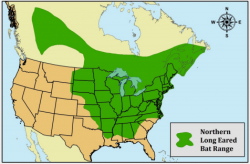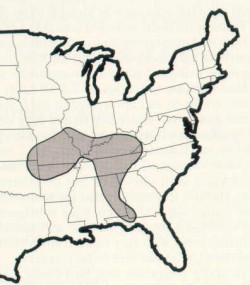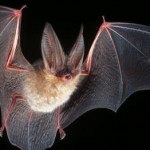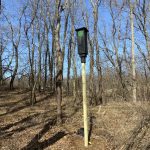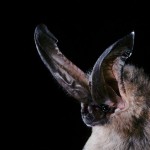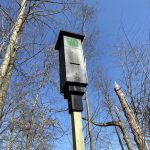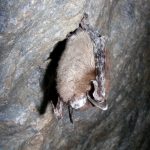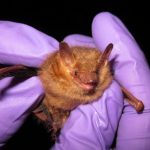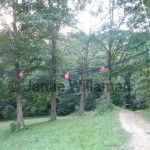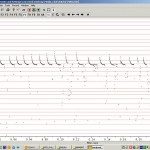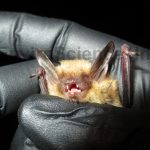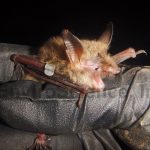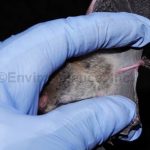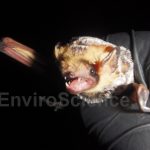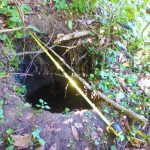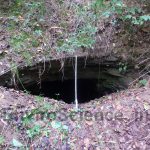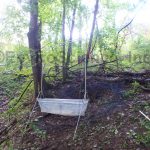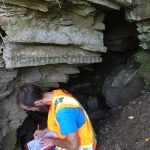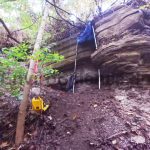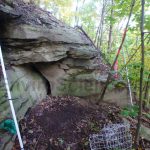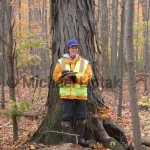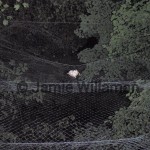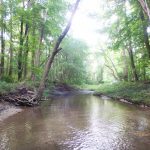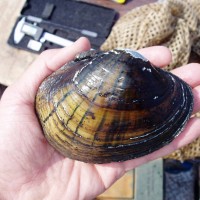Bat Surveys
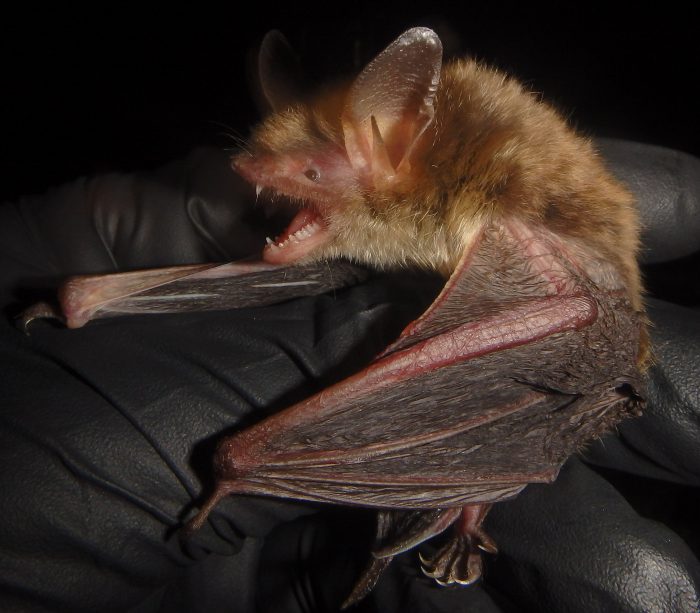
Northern long-eared bat (Myotis septentrionalis)
The U.S. Fish and Wildlife Service (USFWS) protects critically imperiled species from extinction by regulating harm (or “Take”) of listed animals and their habitat through the regulations set forth in the Endangered Species Act of 1973 (ESA). Additionally, state wildlife resource agencies further regulate the harm of species that occur in low numbers within the state borders. As protection for listed species, the USFWS has established a coordination and permitting structure that project proponents need to comply with to ensure that no harm is done to an already imperiled species.
EnviroScience biologists are highly familiar with the coordination process and bat survey services that may be required as a result. We have experience with projects of all types and sizes across the range of both state and federally listed bat species. Our clients include federal, state, and local government agencies, coal, energy, and industry companies, transportation departments, developers, and private companies. EnviroScience rare bat survey capabilities include:
- Full coordination with USFWS and state regulatory agencies
- Records Search and Desktop Review
- Habitat, Tree, and Potential Hibernacula Surveys
- Emergence Surveys
- Mist-net Surveys
- Acoustical Monitoring
- Radiotelemetry
- Habitat Conservation Plans
- Biological Assessments
EnviroScience strongly recommends initiating the coordination process with both the USFWS and state agencies as soon as possible in the project planning process to avoid delays or other restrictions to project completion. Listed bat species for which coordination may be necessary include the Indiana bat, northern long-eared bat, Virginia big-eared bat, and the gray bat, as detailed below. EnviroScience can assist with coordination and surveys for these and any other bat species as needed.
FEDERALLY ENDANGERED INDIANA BAT SURVEYS
The Indiana bat (Myotis sodalis) is a medium-sized bat that was listed as a federally endangered species by the USFWS in 1967. As a listed species, activities that may affect the species are regulated by the USFWS.
The Indiana bat is considered a cave-dwelling bat, in that it hibernates in caves during cold winter months. In the warmer spring and summer months, the Indiana bat uses forested habitats across its range to roost, forage, and rear young. Because of their summer use of forested habitats, projects that involve clearing or removal of trees or other potential habitats must go through coordination with the USFWS and state agencies.
FEDERALLY ENDANGERED VIRGINIA BIG-EARED BAT SURVEYS
The Virginia big-eared bat (Corynorhinus townsendii virginianus; VBEB) is a medium-sized bat with long ears and distinct facial glands around its snout. The VBEB was listed as a federally endangered species by the USFWS in 1979. It occurs in a very small range including select counties in Kentucky, North Carolina, Virginia, and West Virginia.
The VBEB lives in caves, usually associated with oak-hickory or beech-maple-hemlock forested areas, in both the winter and summer. As a listed species, activities that may affect the species or their habitat are regulated by the USFWS and state agencies.
FEDERALLY ENDANGERED OZARK BIG-EARED BAT SURVEYS
The Ozark big-eared bat (Corynorhinus townsendii ingens; OBEB) is another medium-sized bat with long ears and distinct facial glands around its snout. The OBEB was listed as a federally endangered species by the USFWS in 1979. It is endemic to the Ozark Highlands and Boston Mountains in Arkansas, Missouri, and Oklahoma.
The OBEB lives in limestone and sandstone talus caves year-round, usually associated with oak-hickory hardwood forested areas. As a listed species, activities that may affect the species or their habitat are regulated by the USFWS and state agencies.
FEDERALLY ENDANGERED NORTHERN LONG-EARED BAT SURVEYS
The northern long-eared bat (Myotis septentrionalis; NLEB) is a medium-sized bat that closely resembles the Indiana bat in physical and behavioral characteristics, but has long ears that extend past the snout when pushed forward.
The NLEB is also a cave-dwelling bat that hibernates in caves during the winter months, then roosts and rears young in forests across its range in the spring and summer. In response to a disease called White Nose Syndrome (WNS), which is a fungus that depletes the energy reserves of hibernating bats and causes mortality upon arousal from hibernation, the USFWS listed the NLEB as federally threatened with an interim 4(d) rule on May 4, 2015.
UPDATE: On November 29, 2022, the USFWS announced a final rule to reclassify the NLEB as endangered under the ESA. The rule takes effect on March 31, 2023. This change in status from threatened to endangered signifies that this species requires additional conservation efforts to address the impacts of its primary threat of WNS. When final, this rule will nullify the prior 4(d) rule that provided specific protections for the species since it was listed as threatened in 2015.
FEDERALLY ENDANGERED GRAY BAT SURVEYS
The gray bat (Myotis grisescens) is another medium-sized bat of the Myotis genus which was listed as a federally endangered species by the USFWS in 1976.
Similar in appearance to the Indiana bat and the northern long-eared bat but larger and with a uniform gray pelage, the gray bat occupies caves year-round, cold caves in the winter and warm caves in the summer. Foraging is usually associated with rivers, streams, lakes, or reservoirs. As a listed species, activities that may affect the species are regulated by the USFWS and state agencies.
TRICOLORED BAT SURVEYS (PROPOSED LISTING)
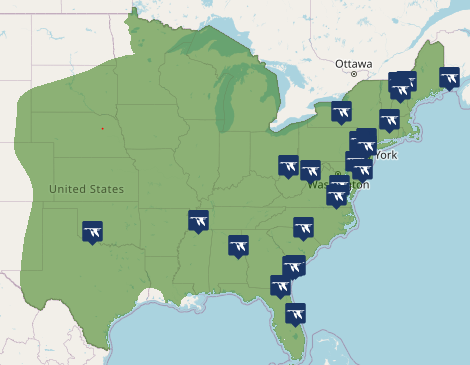
Tricolored Bat Range (Source: USFWS)
On September 13, 2022, the USFWS announced a proposal to list the tricolored bat (Perimyotis subflavus) as endangered under the ESA. Based on a thorough review of the species’ status, the species was found to have declined so dramatically across its range that it now meets the definition of endangered under the ESA. White-nose syndrome has caused estimated declines of more than 90% in affected tricolored bat colonies and is currently present across 59% of the species’ range.
The proposed rule to list the tricolored bat as endangered appears in the September 14, 2022, Federal Register. The comment period for the proposed rule to list the tricolored bat as endangered closed on November 14, 2022. The USFWS is currently evaluating all information received during the comment period and will announce a final decision within 12 months. EnviroScience will continue to post updates on the status of these bats and updates to regulatory guidelines.
In Action
- Virginia Big-eared Bat
- Ozark Big-eared Bat
- Mist Net
- Anabat System Bat Acoustic Monitoring
- Northern long-eared bat (Myotis septentrionalis)
- Northern long-eared bat (Myotis septentrionalis)
- Keeled Calcar of Indiana Bat
- Hoary Bat
- Harp Trap
- Bat Portal Survey
- Bat Portal Survey
- Harp Trapping
- Hibernacula Survey
- Trapping Potential Bat Hibernacula
- Trapping Potential Bat Hibernacula
- Bat Roosting Tree
- Mist Netting
- Mist net over stream
Need help with your project?
Our experts are here to discuss your needs and how we can help you move your project forward. Fill out the form below for more information on our services or to request a quote, and we’ll get back to you within 24 hours. If you need a response within an hour or less, please call us at 800-940-4025.
Few environmental firms in the country retain EnviroScience’s degree of scientific know-how, talent, and capability under one roof. The diverse backgrounds of our biologists, environmental engineers, scientists, and divers enable us to provide comprehensive in-house services and an integrated approach to solving environmental challenges—saving clients time, reducing costs, and ensuring high-quality results.
Our client guarantee is to provide “Excellence in Any Environment,” meaning no matter what we do, we will deliver on our Core Values of respect, client advocacy, quality work, accountability, teamwork, and safety. EnviroScience was created with the concept that we could solve complex problems by empowering great people. This concept still holds true today as our scientists explore the latest environmental legislation and regulations and incorporate the most up-to-date technology to gather and report data.
EnviroScience expertise includes but is not limited to: aquatic survey (including macroinvertebrate surveys and biological assessments); ecological restoration; ecological services (including impact assessments, invasive species control, and water quality monitoring); emergency response; engineering and compliance services; endangered mussel surveys; laboratory and analysis; stormwater management; threatened and endangered species; and wetlands and streams (including delineation and mitigation). Further, EnviroScience is one of the few biological firms in the country that is a general member of the Association of Diving Contractors International (ADCI) and offers full-service commercial diving services.



